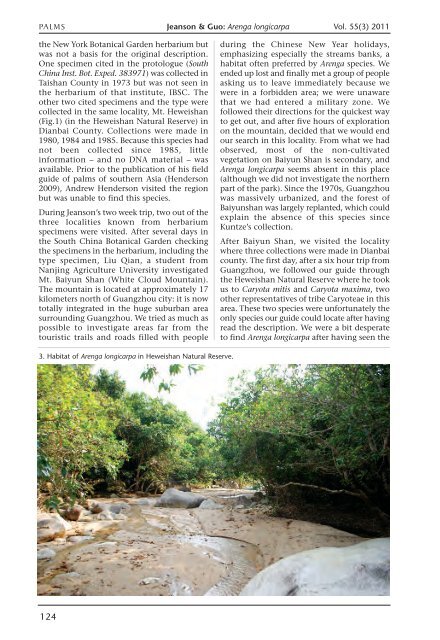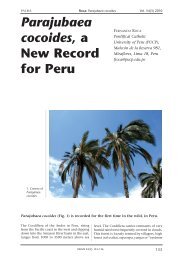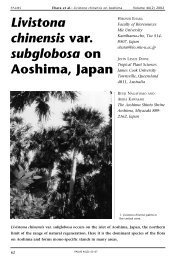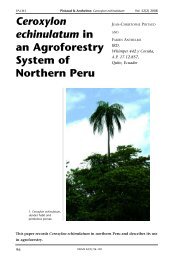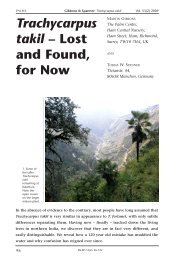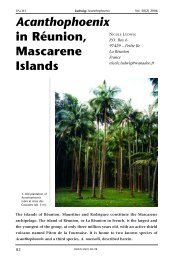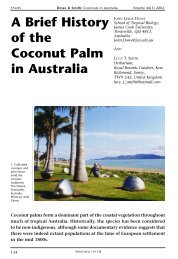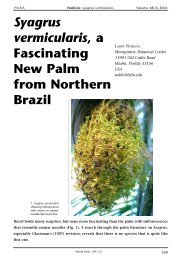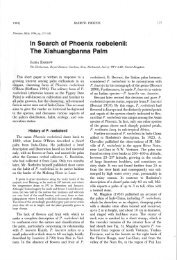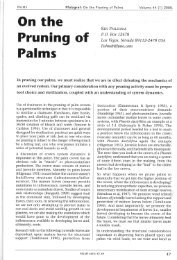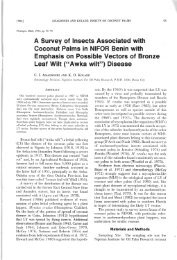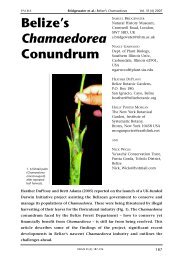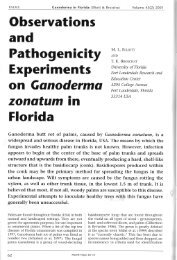Arenga longicarpa, a Poorly Known Species from South China
Arenga longicarpa, a Poorly Known Species from South China
Arenga longicarpa, a Poorly Known Species from South China
Create successful ePaper yourself
Turn your PDF publications into a flip-book with our unique Google optimized e-Paper software.
PALMS Jeanson & Guo: <strong>Arenga</strong> <strong>longicarpa</strong> Vol. 55(3) 2011<br />
the New York Botanical Garden herbarium but<br />
was not a basis for the original description.<br />
One specimen cited in the protologue (<strong>South</strong><br />
<strong>China</strong> Inst. Bot. Exped. 383971) was collected in<br />
Taishan County in 1973 but was not seen in<br />
the herbarium of that institute, IBSC. The<br />
other two cited specimens and the type were<br />
collected in the same locality, Mt. Heweishan<br />
(Fig.1) (in the Heweishan Natural Reserve) in<br />
Dianbai County. Collections were made in<br />
1980, 1984 and 1985. Because this species had<br />
not been collected since 1985, little<br />
information – and no DNA material – was<br />
available. Prior to the publication of his field<br />
guide of palms of southern Asia (Henderson<br />
2009), Andrew Henderson visited the region<br />
but was unable to find this species.<br />
During Jeanson’s two week trip, two out of the<br />
three localities known <strong>from</strong> herbarium<br />
specimens were visited. After several days in<br />
the <strong>South</strong> <strong>China</strong> Botanical Garden checking<br />
the specimens in the herbarium, including the<br />
type specimen, Liu Qian, a student <strong>from</strong><br />
Nanjing Agriculture University investigated<br />
Mt. Baiyun Shan (White Cloud Mountain).<br />
The mountain is located at approximately 17<br />
kilometers north of Guangzhou city: it is now<br />
totally integrated in the huge suburban area<br />
surrounding Guangzhou. We tried as much as<br />
possible to investigate areas far <strong>from</strong> the<br />
touristic trails and roads filled with people<br />
during the Chinese New Year holidays,<br />
emphasizing especially the streams banks, a<br />
habitat often preferred by <strong>Arenga</strong> species. We<br />
ended up lost and finally met a group of people<br />
asking us to leave immediately because we<br />
were in a forbidden area; we were unaware<br />
that we had entered a military zone. We<br />
followed their directions for the quickest way<br />
to get out, and after five hours of exploration<br />
on the mountain, decided that we would end<br />
our search in this locality. From what we had<br />
observed, most of the non-cultivated<br />
vegetation on Baiyun Shan is secondary, and<br />
<strong>Arenga</strong> <strong>longicarpa</strong> seems absent in this place<br />
(although we did not investigate the northern<br />
part of the park). Since the 1970s, Guangzhou<br />
was massively urbanized, and the forest of<br />
Baiyunshan was largely replanted, which could<br />
explain the absence of this species since<br />
Kuntze’s collection.<br />
After Baiyun Shan, we visited the locality<br />
where three collections were made in Dianbai<br />
county. The first day, after a six hour trip <strong>from</strong><br />
Guangzhou, we followed our guide through<br />
the Heweishan Natural Reserve where he took<br />
us to Caryota mitis and Caryota maxima, two<br />
other representatives of tribe Caryoteae in this<br />
area. These two species were unfortunately the<br />
only species our guide could locate after having<br />
read the description. We were a bit desperate<br />
to find <strong>Arenga</strong> <strong>longicarpa</strong> after having seen the<br />
3. Habitat of <strong>Arenga</strong> <strong>longicarpa</strong> in Heweishan Natural Reserve.<br />
124


